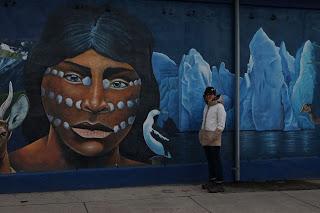
Estas tierras tienen muchos mitos y leyendas por lo que vamos a volver a hacer lo que ya hicimos en Nueva Zelanda con los mitos maoríes. Intentaremos acabar las actualizaciones con algún mito o leyenda de los diversos pueblos que han habitado la zona. Y para contextualizar un poco hacemos esta breve entrada donde os presentamos a los tres pueblos principales de La Patagonia, dos de ellos extintos ya.LOS SELK’NAM
Selk’nam, hombre de a pie, es el nombre que se daban a sí mismos los Onas, los habitantes de La Tierra del Fuego y parte del sur de La Patagonia. Fueron exterminados por completo a principios del siglo XX por estancieros (ganaderos a cargo de una Estancia o Rancho) de ovejas. La última Ona, Lola Keipja, murió en 1983.LOS TEHUELCHES
A la gente original de La Patagonia se la conoce por diferentes nombres: los Mapuches les llamaron Tehuelches, que significa gente brava. Los primeros exploradores europeos les llamaron Patagones, que deriva del castellano “patones” o de pies grandes. Ellos mismos se conocían como Aonek’enk. Su situación es de completa extinción en Chile, habiendo sido vistos por última vez cazando guanacos en 1927.LOS MAPUCHESLos Mapuches, hombres de la tierra, son un pueblo amerindio que habitaba el sur de Chile y Argentina al que los Españoles denominaron Araucanos, por estar en la región histórica de Araucania. Los que vivían más hacia el norte estaban bajo influencia del Imperio Inca, por lo que acabaron siendo sometidos por los Conquistadores Españoles, pero los que estaban hacia el sur resistieron. A finales del siglo XIX fueron sometidos por Chile y Argentina en la Pacificación de la Araucanía y la Conquista del Desierto. Se exterminó a la mayoría, se les requisaron todas sus tierras, se encerró a los supervivientes en reservas como a animales y se eliminaron todos sus símbolos de identidad y expresión cultural. Actualmente habitan en areas urbanas donde sufren una gran discriminación racial y social, viviendo la mayoría en la pobreza y la marginación.
Enrique & MarinaEnglish versionPATAGONIA’S FIRST NATIONS

This land has many myths and legends and that’s why we are going to do again what we did in New Zealand with the Maori cosmogony. We will try to finish each update of the blog with either a myth, a story or a legend that belongs to one of the original tribes that inhabited this area. But now, with the aim of helping you settling in where we are, we are just introducing the three main Patagonian original settlers, being two of them already extinctTHE SELK’NAM
Selk’nam, the walking man, is the name that the Ona people gave to themselves, the first inhabitants of Tierra del Fuego and the South of Patagonia. They were wiped out completely on the early XX th century by sheep estancieros (ranch owners). The last Ona, Lola Keipja, died in 1983.THE TEHUELCHES
The first settlers of the Patagonia are known by many names but the Mapuches called them Tehuelches, that means brave people. The first European explorers called them Patagones, that comes from the Spanish “patones” or people with big feet. The Tehuelches called themselves the Aonek’enk. They are completely vanished in Chile; they were last seen hunting guanacos back in 1927.THE MAPUCHESThe Mapuches, people from the land, are an amerindian tribe that inhabited the South of Chile and Argentina, named Araucanos by the Spaniards, because they lived in the historical region of Araucania. The ones that lived more to the North were under the influence of the Inca Empire so they became dominated by the Spanish Conquistadores. The ones that inhabited the South resisted. But at the end of the XIX th century they were dominated by Chile and Argentina during the Pacificación de la Araucanía and the Conquista del Desierto. The majority were exterminated, all their land and properties were stolen, the survivors were sent to reservations like animals and all their identity and cultural symbology was erased. Nowadays they live in urban areas where they suffer huge discrimination, both ratial and social, the majority of them living in poverty and marginality.Enrique & Marina
